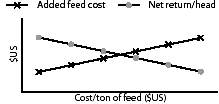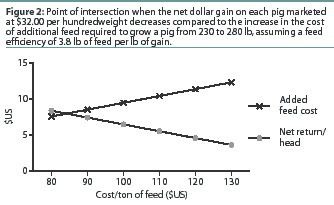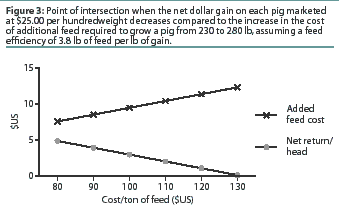What's your interpretation? |
Non refereed |
Market changes that signal lighter pigs and more time between groups
Thomas J Fangman, DVM, MS, Diplomate ABVP-SHM
University of Missouri, A331 Clydesdale Hall, Columbia, MO 65211; Tel: 573-882-7848; Fax: 573-884-9139; E-mail: fangmant@missouri.edu.
Fangman TJ. Market changes that signal lighter pigs and more time between groups. J Swine Health Prod. 2002;10(6):298-299.
This figure demonstrates the point of intersection that occurs when finishing feed prices rise and the net return for hogs marketed at $40.00 per hundredweight declines. Assuming a feed efficiency of 3.8 lb of gain/lb of feed, should hogs be marketed at <280 lb as feed prices rise and market price falls?

The average market weight of pigs today is in excess of 260 lb, and at this writing, there appears to be a tendency for market weight to continue to increase. In order to establish an average weight of 260 lb, some producers may set a targeted marketing weight of 280 lb. Some packers are emphasizing the importance of larger pigs, as more pounds of pork can be processed per available shackle space. Some production managers attempt to maximize profitability by economically evaluating the pounds of pork produced per square foot of available finishing facilities. These combined forces continue to send a signal to producers and veterinarians that bigger, lean pigs are more profitable. However, producers are beginning to recognize the value of pig flow rather than pig size. As certain market conditions begin to change, such as the increasing price of feed, greater consideration may need to be given to decreasing days to market by shipping pigs at a lighter weight.
When feed costs are low and market price received approaches or exceeds the cost of production, the additional revenue generated from the net gain for pigs grown an additional 50 lb (from 230 to 280 lb) at an assumed feed efficiency (FE) of 3.8 remains at $7.65 per head, even when feed costs approach $130.00 per ton (Figure 1). When marketing conditions favor this situation, there is good economic reason for producers to provide an adequate number of days for pigs to grow to higher market weights.

When market price is $40.00 per hundredweight at a time when feed prices begin to rise, the net gain per head does not intersect the line for the cost of the added feed until the cost of that added feed exceeds $110.00 per ton. Even at that point, there is still a net gain of $10.50 per pig, and the economic message is to keep feeding the pigs to a heavier market weight.
However, if the market price received begins to drop below the cost of production at a time when feed prices begin to rise, producers may need to establish a trigger indicator that will show when pigs should be marketed at a lighter weight. This allows more down time between groups and potentially more time for clean-up and repair of barns before the next group of pigs flow into the facility. This situation is demonstrated in Figure 2. In this example, when the market price for pigs is $32.00 per hundredweight, the line for net gain of pigs fed additional feed intersects the line for the cost of feed at $80.00 per ton. In this example, as feed costs approach $110 per ton, the net gain of feeding pigs to 280 lb drops to $5.55.

It is difficult to assign a value to increased time allowed between groups. Many economists maintain that there is a fixed cost to any facility, whether or not there are pigs in it. These figures demonstrate that during certain marketing times, the net gain of feeding pigs to higher market weights diminishes rapidly (Figure 3). A producer may decide to market pigs when the faster-growing pigs reach a maximum targeted weight of 260 lb (instead of 280 lb) and market pigs more frequently (if production volume allows) to assure that no light pigs are shipped. This will decrease the days to market and potentially increase the amount of time available between turns of the barn. During these times, there will be an opportunity to conduct minor repairs and improve the environment for the next group of pigs. Producers may be able to accomplish these tasks when feed costs and market price reach the trigger indicating that net gain differences for feeding pigs to higher market weights has now reached a point when lighter pigs (still within the price matrix of the packer) should be marketed, allowing additional time between groups.

Acknowledgements
I would like to personally thank and acknowledge the efforts of Dr Steve Henry of the Abilene Animal Hospital in Abilene, Kansas, for creating the spreadsheet tool that allowed us to make our comparisons. This spreadsheet tool was made available through the shareware session of the 2001 Leman Conference in Minneapolis, Minnesota.
